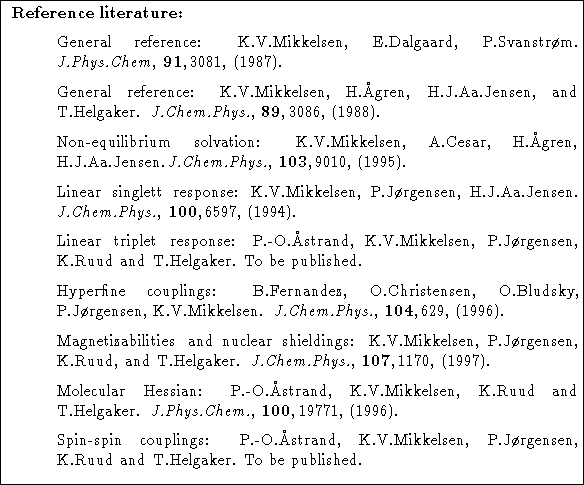

The necessary input for a solvent calculation is given in the **INTEGRALS and **WAVE FUNCTIONS input modules. A typical input file for an SCF calculation of the nuclear shielding constants of a molecule in a dielectric medium will look like :
**DALTON INPUT .RUN PROPERTIES **INTEGRALS *ONEINT .MAX L 10 **WAVE FUNCTIONS .HF *SOLVENT .DIELECTRIC 78.5 .MAX L 10 .CAVITY 3.98 **PROPERTIES .SHIELD *END OF INPUT
In **INTEGRALS we request the evaluation of the undifferentiated solvent multipole integrals as given in for instance Ref. [56] by the keyword .MAX L in the *ONEINT submodule. We request all integrals up to L=10 to be evaluated. This is needed if static or dynamic (response) properties calculations are to be done, but is not needed for a run of the wave function only (**WAVE FUNCTIONS ).
In **WAVE FUNCTIONS
there is a separate input module for the
solvent input,
headed by the name *SOLVENT
. We refer to Sec.  for a presentation of all possible keywords in this submodule. The
interaction between the solute and the dielectric
medium is
characterized by three parameters; the dielectric
constant , the cavity
size, and the order of the multipole expansion . In the above input we have
requested a dielectric constant of 78.5 (corresponding to water )
through the keyword .DIELECTRIC
, a cavity radius of 3.98 atomic
units with the keyword .CAVITY
, and the multipole expansion is to
include all terms up to L=10, as can be seen from the keyword
.MAX L
. Note that this number cannot be larger than the number given for
.MAX L
in the *ONEINT
input module.
for a presentation of all possible keywords in this submodule. The
interaction between the solute and the dielectric
medium is
characterized by three parameters; the dielectric
constant , the cavity
size, and the order of the multipole expansion . In the above input we have
requested a dielectric constant of 78.5 (corresponding to water )
through the keyword .DIELECTRIC
, a cavity radius of 3.98 atomic
units with the keyword .CAVITY
, and the multipole expansion is to
include all terms up to L=10, as can be seen from the keyword
.MAX L
. Note that this number cannot be larger than the number given for
.MAX L
in the *ONEINT
input module.